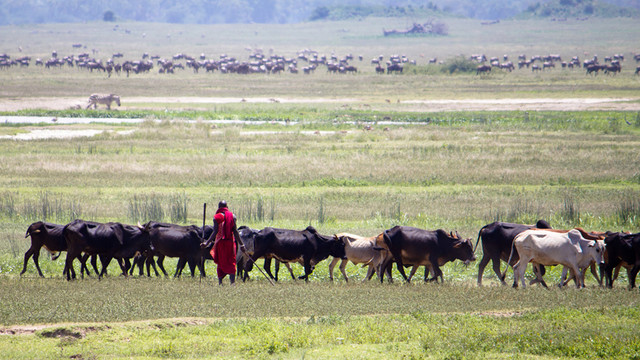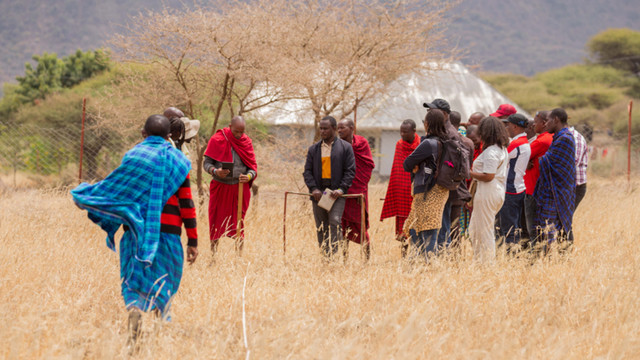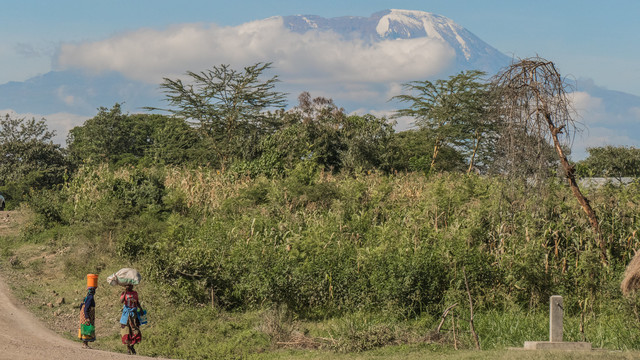CBA10 field trips: adaptation in practice
The 10th International Conference on Community-Based Adaptation offered field trips to see how people in urban environments are taking practical steps to deal with the impacts of climate change. IIED's Matt Wright reports.


A CBA10 field trip group, from countries ranging from England to Nepal, poses for a photo at the end of a long day during which the delegates made visits to four separate projects in Dhaka where communities are adapting to climate change (Photo: Matt Wright/IIED)
When you ask participants about the best part of the conferences on community-based adaptation (CBA), the overwhelming response is the field trips.
From Kathmandu to Nairobi, and from Dar Es Salaam to Hanoi, the 10 CBA conferences have included field trips to see how local communities are adapting to the challenges of climate change, and opportunities to share real-world experiences and knowledge. These excursions have been cited by many as the highlights of the week-long event.
This year I can add my own voice of praise. In roughly 10 hours we had the opportunity to meet a huge number of people working at the climate change coalface, ranging from the executive director of a Bangladesh NGO working in partnership with Save the Children, to schoolchildren who pressured local authorities to take action to clean a canal.
The visits tallied perfectly with the conference theme of urban community resilience. Here are some of my highlights of the day (click on the smaller images to expand into a photo gallery):

In Dhaka, host city of this year's CBA conference, 14.6 million people live inside an area of just 125 square miles (PDF). The most densely populated city in the world – even Mumbai is around one-third less dense – Dhaka has particular challenges when it comes to dealing with climate change.
Our field trip began in the western part of the city, in Mohammadpur, where we saw how Bangladesh NGO Community Participation and Development (CPD) is working with Save the Children to educate five to 18-year olds about climate change impacts, and to build their capacity to take action.
We learned about several schools where CPD is not only providing information in targeted lessons, but promoting debate and art competitions to engage the wider communities beyond the confines of the school. CPD is also working with teachers to show them how to bring climate change education into the classroom and how to use the right terminology to ensure that children can understand and identify the issues in their own lives.
The schools have even introduced 'oxygen boxes': collection boxes into which pupils place very small amounts of money. This money is used to buy plants to green their campus and create gardens in areas devoid of any plant life. Often the plant holders are adapted from plastic bottles.
We visited Bengali Medium High School, and heard from children in Class 8 as they spoke of their pride in their actions. They explained that most of the plants around the school were neem, because it can tolerate very high levels of pollution and produces a high amount of oxygen. In turn, the children quizzed the conference delegates on what action was being taken in their own countries.
Explaining the way in which CPD works with children, CPD's executive director Moslemi Bari said: "We aim to help them understand that they can do something themselves, and to encourage them to take action, no matter how small. We capacitate the children to raise their voices."
These 'raised voices' were again evident at the next destination, an Eco-friendly Child Club that is attended by up to 50 children two days a week, and which recently successfully campaigned for a nearby canal full of rubbish to be cleaned up by local authorities.
In addition to learning more about climate change, the youngsters encourage their local community to use the club as a library, and often put on themed theatre performances to further educate their friends, family and neighbours.
One student, Lipie, said: "We inform our family about climate issues and how we need to do something as soon as possible to avoid even more problems in the future. In the past, people did not listen as much, but people are now noticing their health suffering, and are realising the connections and the importance."
Another pupil, Salma, talked about paintings that were on display. "These pictures show the importance of trees," she said. "If we don't have oxygen, we cannot survive. We invite our neighbours to come and visit and learn. Nearby there was a house with an empty courtyard; now it is full of plants [after the owner visited us] and we've noticed the whole area is getting greener."
On our way to the next stop, the home of a local 'green champion', we stopped at the canal that was the subject of the children's campaigning. Although our stop was brief, it served to emphasise that the CPD project is not just about theoretical teaching but delivers action and results.
A green champion
The green champion has converted whatever space she possesses – in her flat, on her balcony, on an area of the roof – to become a miniature forest amid the urban jungle.
Not only do plants act as heat and water absorbers, the plants on her balcony act as a shield to help prevent dust from the Dhaka streets from entering her home.
The final destination on our field trip was Sher-e Bangla Agriculture University, where we learned about a roof garden initiative supported by the Islamic Relief Bangladesh.
Researchers told us about research that shows that implementing rooftop gardens on a variety of scales can reduce the CO2 concentration in the atmosphere and reduce the urban heat island effect that plagues megacities around the world. What’s more, they provide greater thermal performance and roof insulation for the building on which they are mounted.
A small oasis high above the busy city, the rooftop garden was the perfect spot to end the day and reflect on what we learned. And no doubt, it will be the basis for dozens of fascinating discussions to come in the conference itself.
- Read a round-up of field trips at CBA10 compiled via the Storify platform.
Matt Wright (matthew.wright@iied.org) is IIED's web planning and content manager. Follow his tweets from Dhaka and CBA10 via @IIED and @mattjobob.


















